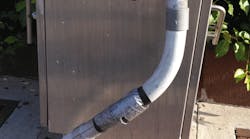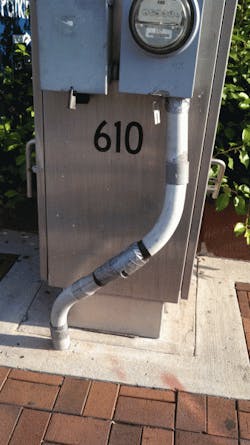How well do you know the Code? Think you can spot violations the original installer either ignored or couldn't identify? Here's your chance to moonlight as an electrical inspector and second-guess someone else's work from the safety of your living room or office. It's your turn to identify the violation.
Hint: One more use for duct tape
Find the Answer
Thanks to Dale D. Hoffart, a senior electrical designer from Lincoln, Neb., for sharing this photo with us. It’s just another fine example of how to use duct tape on the job.
Section 110.8 states, “Only wiring methods recognized as suitable are included in this Code.” I don’t know about you, but I cannot find “duct tape wiring methods” anywhere in the NEC — yet there it is being used as a coupling for the pipe in this photo.
Section 352.6 requires PVC and its fittings to be listed. To the best of my knowledge, duct tape is not listed for this purpose. Sec. 352.48 requires joints between conduit lengths, fittings, and boxes to be made in an approved manner. I suppose if the AHJ approved this method then it may be permitted, but a knowledgeable inspector would know that there are listed fittings and solvent cements that are specifically made for making joints in PVC conduit — and would most likely reject this technique.
I am also concerned about the pipe getting damaged from ground movement as recognized in Sec. 300.5(J) or thermal expansion and contraction of the PVC as recognized in 352.44. The use of a PVC expansion fitting could help alleviate either of these potential problems.





